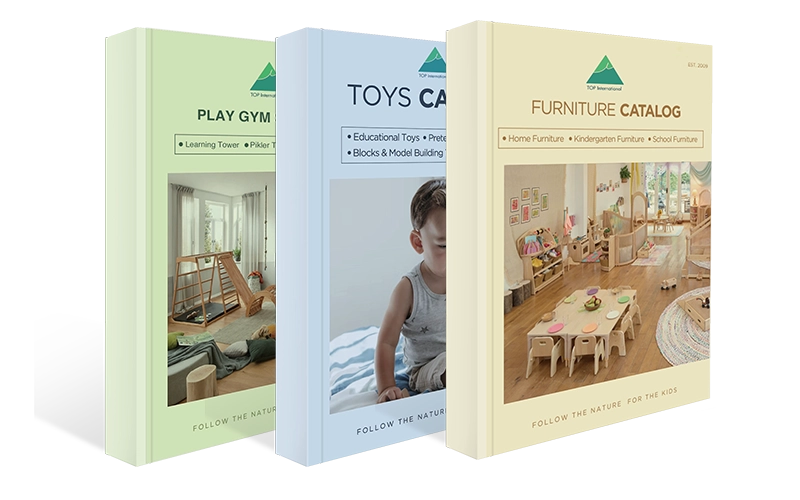Are you struggling to choose the right educational approach for your preschool classroom?
Have you ever worried that your teaching methods might not meet the developmental needs of young children? Do you wonder if following Developmentally Appropriate Practice (DAP) could make a real difference in children’s growth and learning?
Choosing the right approach is critical in early education. Developmentally Appropriate Practice (DAP) is a proven guideline that ensures teaching matches children’s age, individual needs, and cultural backgrounds. Applying DAP effectively fosters holistic growth—socially, emotionally, cognitively, and physically—setting children up for lifelong success.
Understanding Developmentally Appropriate Practice is just the beginning. Stay with me — mastering DAP can be the key to building a preschool environment where every child thrives.

The History of Developmentally Appropriate Practice: How Did We Get Here?
Understanding developmentally appropriate practice begins with tracing its roots.
The meaning of DAP is best appreciated by exploring how educational theories evolved over the last century.
In the early 20th century, educators like John Dewey promoted a child-centered educational model. Dewey challenged traditional notions of passive learning, laying the foundation for practices that honor children’s developmental needs and individual pathways.
Later, Jean Piaget’s cognitive development theory and Lev Vygotsky’s socio-cultural theory further expanded on this.
Their combined influence led to what we understand today as the DAP definition: education that respects the child’s developmental stages, individuality, and cultural context.
In 1987, the National Association for the Education of Young Children (NAEYC) published formal guidelines, providing a structured framework for early childhood programs committed to applying developmentally appropriate practice.
Since then, research has continuously refined how educators understand and meet the needs of young learners.
Today, respecting children’s development is not merely recommended—it is viewed as a fundamental professional and ethical responsibility.
The historical journey highlights that supporting children’s growth goes beyond simple age-based teaching; it requires nurturing the whole child—emotionally, cognitively, socially, and physically—within a responsive and inclusive environment.
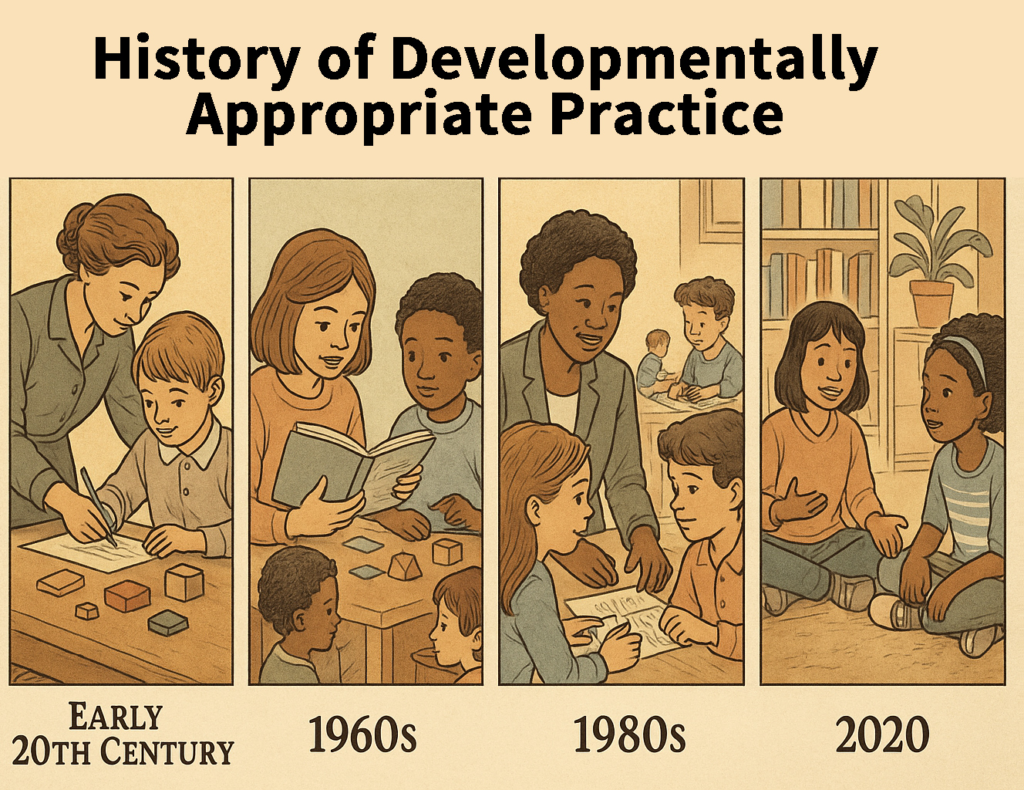
Why Is DAP Important?
If we wish to educate children in ways that honor who they are and who they can become, developmentally appropriate practice is non-negotiable.
This framework not only supports academic learning but nurtures the whole child—emotionally, physically, cognitively, and socially.
Let’s explore why developmentally appropriate practice in early childhood is so vital.
Nurturing Emotional and Social Skills
Children’s emotional well-being lies at the foundation of Advancing Cognitive Growth.
Developmentally appropriate practice activities foster deep cognitive development without relying on rote memorization or rigid academic drills.
Children are encouraged to:
- Explore open-ended questions
- Engage in inquiry-based projects
- Solve real-world problems collaboratively
By emphasizing hands-on, relevant learning experiences, educators ensure that cognitive skills are built on strong, meaningful foundations rather than superficial memorization.
Educators who explain developmentally appropriate practice understand that authentic learning emerges from curiosity and connection, not compliance. All future learning.

Advancing Cognitive Growth
When classrooms are designed according to developmentally appropriate practices, they promote:
- Trusting relationships with adults and peers
- Emotional regulation strategies
- Conflict resolution and negotiation skills
Teachers create emotionally safe environments by listening actively, validating feelings, and modeling respectful communication.
This focus on social-emotional development mirrors what the definition of developmentally appropriate practice requires: a respect for each child’s full humanity.
Encouraging Physical Skills Development
Physical activity is integral to healthy development, especially in early childhood.
Developmentally appropriate practices support gross and fine motor growth through:
- Daily outdoor play
- Building and construction activities
- Art projects that develop hand strength and dexterity
Teachers integrate movement into learning, using games, dance, and manipulatives to help children strengthen their bodies and minds simultaneously.
Ignoring children’s natural need for movement violates the spirit of developmentally appropriate practices for early childhood education and undermines overall growth.
Responding to Individual Strengths and Preferences
Children bring diverse experiences, abilities, and cultural backgrounds into the classroom, and these differences should be embraced rather than minimized. Developmentally appropriate practice in preschool settings respects teachers who differentiate instruction by:
- Offering choices in learning activities
- Observing children’s interests and passions
- Adjusting expectations based on developmental levels, not arbitrary benchmarks
When education is personalized, children feel valued.
This aligns directly with developmentally and culturally appropriate practice, where children’s backgrounds and identities are honored.
Responding flexibly to individual strengths is a hallmark of developmentally appropriate practice in classrooms that recognize every child has unique talents, needs, and rhythms.
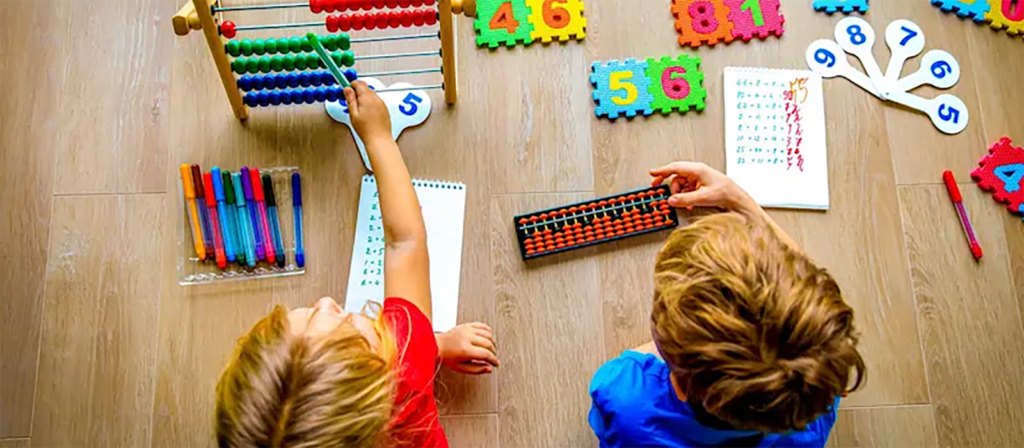
Laying the Groundwork for Lifelong Learning
Finally, the ultimate goal of developmentally appropriate practice is not just preparing children for the next grade level.
It is laying the foundation for lifelong curiosity, resilience, empathy, and joy in learning.
Children who are empowered in their earliest educational experiences:
- Approach challenges with confidence
- Maintain intrinsic motivation
- Develop strong problem-solving and critical thinking skills
The importance of developmentally appropriate practice lies in building not just good students but good human beings.
When schools and families commit to these principles, we ensure that education is not merely preparation for life—it is life itself.
3 Core Considerations of Developmentally Appropriate Practices
When educators seek to explain developmentally appropriate practice, they often reference three foundational principles: Commonality, Individuality, and Context.
These principles form the essence of developmentally and culturally appropriate practice and ensure that educational methods truly serve all children’s needs.
Commonality
The first consideration in developmentally appropriate practice in preschool settings is an understanding of common milestones.
Developmentally appropriate practice activities are based on research about what children typically achieve at certain ages.
Knowing these milestones helps teachers craft experiences aligned with children’s developmental capabilities.
For instance, understanding that four-year-olds are beginning to develop early literacy skills helps educators design developmentally appropriate practice activities for preschoolers that build pre-reading competencies through playful exploration.
The developmentally appropriate practice of commonality ensures that educational goals are both realistic and inspiring for all learners.
However, relying solely on general trends without acknowledging individual differences can lead to ineffective practices—this is where the following principle, individuality, becomes crucial.
Individuality
While commonality provides the general map, individuality provides the detailed route.
Recognizing individual differences is key to developmentally appropriate practices in early childhood.
Every child has a unique learning style, pace, and set of experiences.
Effective preschool developmentally appropriate practices take these differences into account, ensuring that each child feels seen and valued.
When educators define developmentally appropriate practice, they emphasize adapting teaching strategies to meet individual needs.
This can include adjusting classroom materials, offering alternative ways to demonstrate knowledge, or providing emotional support tailored to a child’s background.
Through individualized support, children not only learn academic skills but also build resilience, self-esteem, and critical thinking abilities—all hallmarks of developmentally appropriate teaching practices.
Individuality must also consider special needs education.
Implementing for infants or children with disabilities requires specialized training and a deep respect for each learner’s journey.
Context
The third primary principle in developmentally appropriate practice in the classroom is understanding the socio-cultural context in which a child grows.
Developmentally appropriate practices are most likely to be effective when they honor a child’s home language, traditions, and values.
Incorporating context is an essential part of developmentally appropriate practice in early childhood education.
Classrooms that respect diversity, celebrate inclusion, and integrate cultural relevancy foster stronger connections between home and school.
For example, classrooms adopting early childhood programs should feature bilingual materials if their students come from multilingual homes.
Educators trained in training are well-equipped to use culturally responsive strategies that affirm each child’s identity.
By considering context, teachers embody the best of principles of developmentally appropriate practice, creating richer, more meaningful educational experiences.
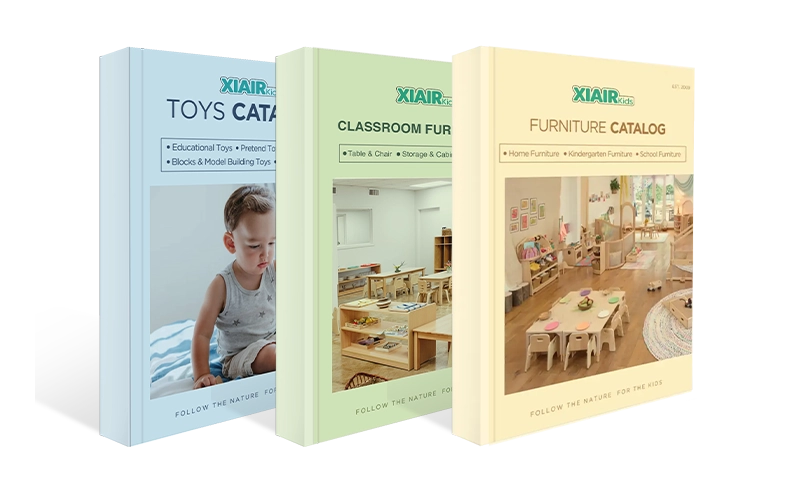
Receive a free catalog and custom layout to help you design your ideal classroom easily.
Principles that Inform Developmentally Appropriate Practice
Understanding the foundational principles that shape developmentally appropriate practice is critical for anyone involved in early childhood education. These principles are not arbitrary guidelines but are grounded in decades of research and reflect the realities of how children grow, learn, and thrive. When educators grasp these principles fully, they can implement teaching strategies that align with the true nature of child development, honoring both individual differences and universal patterns of growth.
1. Development and Learning Arise from the Interplay of Biology and Environment
Children are born with inherent potential shaped by their genetic makeup.
Yet, they realize that potential depends heavily on the environments they experience.
In DAP, preschool classrooms, educators recognize that no two children are identical.
A dynamic interaction between biological predispositions and environmental stimuli influences each child’s growth.
Developmentally appropriate practices emphasize rich, nurturing environments where children’s innate curiosity is met with opportunities to explore and learn.
Educators must continually ask themselves:
- How does this child’s background shape their learning needs?
- How can I adapt the classroom to meet these needs authentically?
This nuanced understanding leads to educational settings where children’s natural abilities can flourish within supportive, stimulating environments.

2. All Domains of Child Development Support Each Other
Children do not develop in isolated domains; their physical, cognitive, social, emotional, and language skills are deeply interconnected. Recognizing this interdependence is fundamental to understanding developmentally appropriate practices.
For instance, a toddler’s physical ability to move around a room independently will influence their cognitive development by enabling exploration. Similarly, a preschooler’s ability to manage emotions (social-emotional development) will significantly affect their success in group learning activities (cognitive development).
This principle demands that teachers use holistic approaches when designing developmentally appropriate practice activities. For example, a game of building a block tower fosters physical coordination, problem-solving, perseverance, and sometimes negotiation with peers.
Therefore, effective preschools ensure that learning experiences are integrative rather than fragmented. An activity might simultaneously encourage early math concepts, motor skills, language development, and social collaboration, thus honoring the interconnectedness of child development domains.
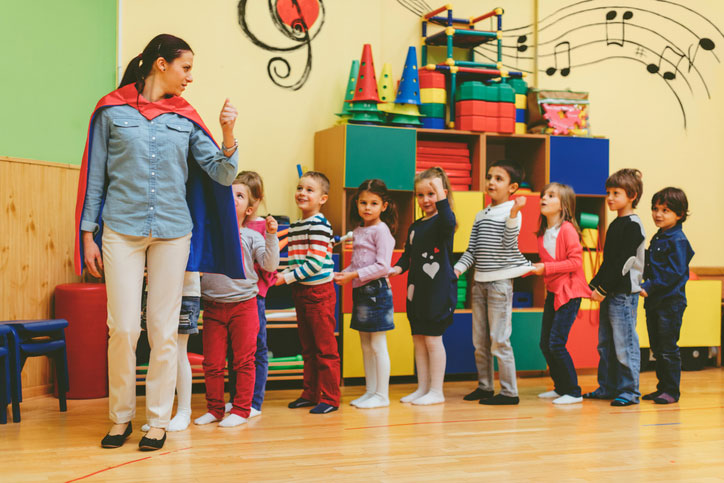
3. Play Fosters Broad Learning and Development and is Vital for Children from Birth to Age 8
Few aspects of early childhood education are as central to developmentally appropriate practices as the role of play. Play is not merely a recreational activity; it is the primary engine through which young children learn.
Through pretend play, children explore social roles, develop language, and practice problem-solving. Physical play supports motor development and health. Constructive play, such as building with blocks, fosters spatial reasoning and early math skills.
Because DAP in early childhood programs values the child’s natural learning inclinations, it prioritizes rich, varied play opportunities. Educators trained in developmentally appropriate practice understand how to structure environments that offer both unstructured free play and guided play experiences aligned with specific developmental goals.
The meaning of developmentally appropriate practice becomes especially clear when observing a child deeply engaged in play: they are exercising autonomy, negotiating meaning, experimenting with cause and effect, and building knowledge—all in ways that are developmentally and cognitively appropriate.
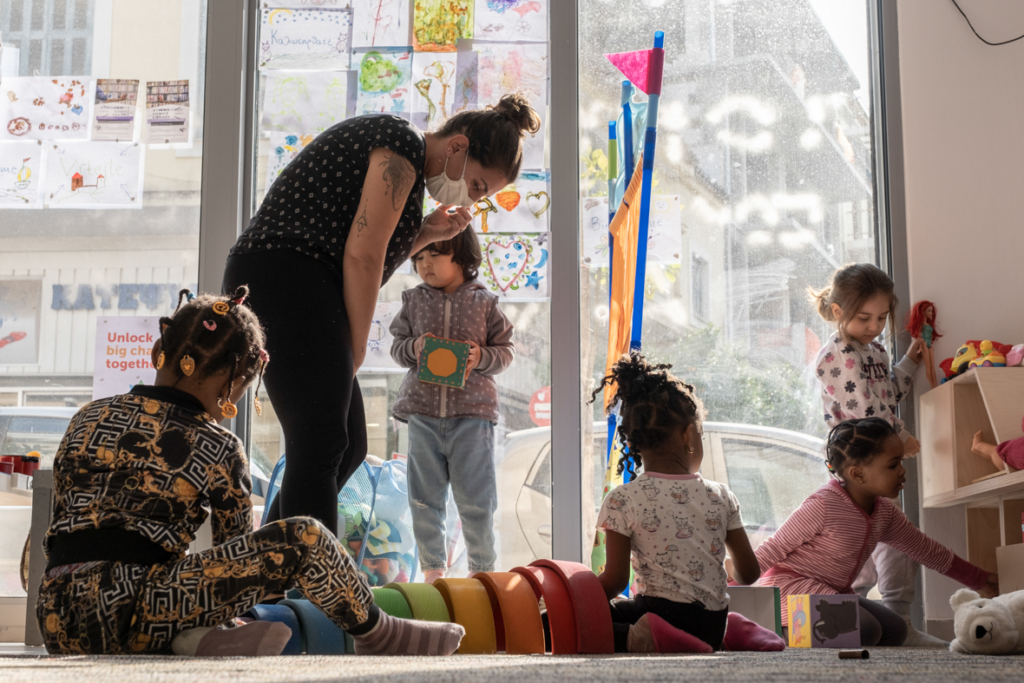
4. Development and Learning Progress Vary with Culture, Experience, and Individuality
No two children are alike, and no educational practice can be truly developmentally appropriate without honoring this diversity.
According to naeyc developmentally appropriate practice standards, effective educators tailor experiences to match children’s unique cultural backgrounds, prior experiences, abilities, and interests.
Incorporating developmentally and culturally appropriate practice means creating inclusive classrooms that celebrate, rather than erase, differences.
Curricula that respect home languages, feature diverse books and materials, and incorporate family traditions foster a more profound sense of belonging for every child.
Understanding that developmentally appropriate practice, meaning, includes cultural relevance, ensures that educators never impose a one-size-fits-all model.
Instead, they craft educational experiences that resonate personally and meaningfully with each child.

5. From Birth, Children Actively Learn by Engaging with People, Environments, and Experiences
Another core truth embedded in developmentally appropriate practice, early childhood approaches, is that children are not passive absorbers of information. From the moment they are born, they are curious, motivated learners, seeking to make sense of the world through relationships, sensory exploration, and active participation.
In preschool settings honors this intrinsic motivation by creating classrooms that are rich in opportunities for hands-on learning. Materials are accessible, environments are arranged thoughtfully, and adults engage with children in ways that extend their thinking rather than deliver facts.
Observations of children’s natural interactions with their surroundings provide essential data for planning meaningful, engaging, developmentally appropriate practice activities for preschoolers. An educator might notice a child’s fascination with insects and build an entire emergent curriculum around that interest, integrating literacy, science, art, and math through a lens that captivates the child’s curiosity.

6. Children Learn Best When They Feel a Sense of Belonging and Purpose, with Curricula Linking School to Home and Community
An essential element of developmentally appropriate teaching practices is fostering a profound sense of belonging. When children feel emotionally safe, respected, and valued, they are more willing to take risks, engage deeply, and persist through challenges.
Curriculum design must bridge children’s home lives and cultural identities with school experiences. Effective early childhood program developmentally appropriate practice connects with families, incorporates community traditions, and values children’s lived experiences.
Through thoughtful family engagement, developmentally appropriate practices for early childhood education ensure that learning is not disconnected from the realities of children’s lives. Such programs build trust, enhance relevance, and strengthen outcomes.
This principle reminds educators that guidelines for developmentally appropriate practice extend beyond the walls of the classroom and require authentic, reciprocal relationships with families and communities.

7. Children Learn Across Subjects, Requiring Educators to Master Content, Progressions, and Teaching Methods
Developmentally appropriate teaching practices demand a broad skill set from educators.
Teachers must not only know content knowledge but also understand developmental progressions and how best to teach each concept in a child-centered way.
For instance, when children engage in a cooking project, they are practicing math skills by measuring ingredients, developing literacy by reading recipes, enhancing fine motor skills through stirring and pouring, and fostering social skills by collaborating with peers. In this way, a simple activity can integrate several subject areas seamlessly.
High-quality kindergarten developmentally appropriate practice ensures that learning across subjects is integrated, purposeful, and developmentally responsive.
Educators committed to early childhood program developmentally appropriate practice continually refine their skills to stay attuned to children’s evolving capacities.

8. Children Grow When Challenged Beyond Their Current Skills and Given Chances to Reflect and Practice
Another critical principle behind developmentally appropriate practices is the concept of optimal challenge. Children learn best when tasks are neither too easy nor impossibly difficult but just beyond their current mastery level—a concept often related to Vygotsky’s “Zone of Proximal Development.”
For example, a child who has just mastered simple addition might be gently introduced to the concept of subtraction through games and real-life scenarios, thus building on existing knowledge while opening new cognitive pathways. Similarly, an emerging reader might be offered texts with slightly increased complexity, encouraging new vocabulary acquisition and comprehension strategies.
The focus on optimal challenge is central to the importance of developmentally appropriate practice because it honors the child’s need for both success and growth. When children experience the satisfaction of mastering a new skill after appropriate effort, their motivation to learn deepens, creating a virtuous cycle of achievement and confidence.

9. When Used Wisely, Technology and Media Can Support Children’s Development and Learning
While traditional models of early childhood education focused heavily on physical materials and face-to-face interaction, modern developmentally appropriate practices recognize that technology, when used thoughtfully, can enrich learning.
Interactive story apps, digital art programs, and video calls with family members across the globe can broaden children’s horizons when embedded within developmentally appropriate practice activities.
However, educators must remain critical consumers of technology, ensuring it supports, not replaces, human interaction and creative exploration.
The definition of developmentally appropriate practice now includes responsible digital citizenship even for the youngest learners.
In classrooms grounded in developmentally appropriate practice that focus on preschoolers, technology is a tool, not a teacher, and always serves to deepen relationships and exploration.


Receive a free catalog and custom layout to help you design your ideal classroom easily.
Using Developmentally Appropriate Exercises in the Classroom
Implementing developmentally appropriate practices in the classroom is essential for fostering environments where children can thrive cognitively, emotionally, socially, and physically. These practices ensure that learning is responsive to children’s developmental stages while also respecting individual differences and cultural contexts.
Using developmentally appropriate exercises means more than following a curriculum; it involves thoughtful, flexible planning that responds dynamically to the needs and interests of the children. Below, we explore several key strategies that embody actual developmentally appropriate practice and offer practical insights into how educators can integrate them into their daily teaching.
1. Establish a Safe, Nurturing Space for Children
A fundamental principle of developmentally appropriate practice is the creation of a classroom environment where children feel physically and emotionally safe. Safety, in this sense, extends beyond the absence of physical hazards; it encompasses emotional security, trust, respect, and belonging.
Classrooms built on developmentally appropriate practice principles include:
- Soft, welcoming physical spaces with child-sized furniture
- Predictable routines that offer structure without rigidity
- A balance of active and quiet areas to meet diverse needs
When children enter a space where they are greeted warmly, their contributions are valued, and their individuality is honored, they are more likely to engage fully and take intellectual risks essential for learning. Developmentally appropriate practices for early childhood education prioritize this kind of nurturing environment because it lays the foundation for all future learning.

2. Monitor and assess each child’s developmental progress.
Effective teaching begins with deep knowledge of each child’s current developmental status. Regular, systematic observation and authentic assessment are key components of developmentally appropriate practice activities.
Monitoring developmental progress allows teachers to:
- Tailor activities to match each child’s current zone of proximal development
- Identify when a child may need additional support or challenges
- Engage families in meaningful conversations about their child’s growth
Through ongoing observation, teachers identify children’s strengths, interests, areas of growth, and preferred learning styles. This information directly informs instructional planning and helps ensure that learning experiences are tailored to meet the unique needs of each child, a fundamental principle of developmentally appropriate teaching practices.
3. Design activities that are age-appropriate and highly engaging.
Children thrive when learning activities align with their developmental capabilities while still challenging them just beyond their current mastery. Designing developmentally appropriate practice activities requires careful thought about both content and delivery methods.
- Reflect examples of developmentally appropriate practice by aligning with typical abilities while offering room for stretch and discovery.
- Offer open-ended exploration rather than one “right” answer
- Be rooted in children’s interests, sparking curiosity and intrinsic motivation
Engaging activities typically involve hands-on exploration, choice, creativity, and collaboration. Passive worksheets or rote memorization exercises do not align with developmentally appropriate practices in early childhood because they fail to activate children’s natural curiosity and problem-solving abilities.

4. Promote learning through play-based experiences.
Play is the foundation of early learning and a centerpiece of developmentally appropriate practices. Far from being a frivolous activity, play is the way young children make sense of the world, build skills, and practice new concepts.
Play promotes:
- Cognitive growth through problem-solving and symbolic thinking
- Social skills through negotiation, collaboration, and conflict resolution
- Physical development through movement and fine-motor challenges
- Emotional strength through risk-taking and resilience-building
Promoting play-based learning also aligns with research-based developmentally appropriate practices for kindergarten, where academic expectations are rising but still must be delivered in ways that honor young children’s need for active, meaningful engagement.
5. Build strong, positive relationships between teachers and children.
The quality of teacher-child relationships is a powerful predictor of children’s success in school and beyond. Developmentally appropriate practice places great emphasis on the social and emotional climate of the classroom, understanding that secure relationships are the foundation for all other learning.
Teachers who build positive, trusting relationships with children:
- Demonstrate consistent warmth and responsiveness
- Respect children’s perspectives
- Provide encouragement rather than excessive praise
- Listen actively and reflectively
- Foster autonomy while offering appropriate support
In classrooms implementing developmentally appropriate practices in preschool, you will often hear teachers using language that affirms children’s feelings, models empathy, and encourages problem-solving rather than issuing commands.

6. Incorporate multisensory methods to enhance learning.
One hallmark of developmentally appropriate practices is the use of multisensory teaching strategies. Young children learn best when they can engage multiple senses—sight, sound, touch, movement—while exploring new concepts. Multisensory learning aligns with children’s natural ways of processing information and helps solidify understanding through diverse neural pathways.
For example, when teaching letter recognition, educators might:
- Let children form letters with clay (tactile and kinesthetic)
- Practice writing letters in sand or shaving cream (tactile)
- Sing alphabet songs (auditory)
- Read alphabet books (visual)
In a developmentally appropriate practice preschool environment, multisensory approaches are not reserved for special occasions—they are woven into the daily fabric of classroom life. Whether counting with physical manipulatives, creating artwork to express emotions, or dramatizing a story, children experience learning through varied, meaningful channels.
7. Encourage teamwork and social interaction among children.
Social interaction is vital to child development, and promoting collaborative learning opportunities is central to developmentally appropriate practice. NAEYC developmentally appropriate practice guidelines highlight that positive peer interactions not only support cognitive growth but also lay the foundation for healthy social and emotional development.
When children work together—whether building a fort, creating a mural, or solving a problem—they practice essential life skills:
- Communication
- Negotiation
- Empathy
- Perspective-taking
- Conflict resolution
Encouraging teamwork helps ensure that children develop not just academic skills but also the interpersonal competencies that are critical for lifelong success, reflecting the true importance of developmentally appropriate practice.

Receive a free catalog and custom layout to help you design your ideal classroom easily.
8. Offer choices to children and support their growing independence.
Autonomy is a fundamental human need, and young children are no exception. Developmentally appropriate practice recognizes that offering children meaningful choices supports their emerging sense of agency, fosters intrinsic motivation, and enhances engagement.
In practice, providing choice might look like:
- Allowing children to select materials for a project
- Offering several different center activities during free play
- Letting children decide the sequence of tasks during work time
- Allowing self-selection of books during quiet reading time
Supporting autonomy does not mean total freedom without structure. Instead, it reflects an intentional design that balances guidance with respect for children’s growing competencies. Such practices directly connect to the definition of developmentally appropriate practice, which emphasizes the whole child’s development—cognitive, social, emotional, and physical.
9. Tailor instruction to meet the unique needs of each child.
One of the most important principles within developmentally appropriate practices in early childhood is the recognition that every child is unique. Children vary in their backgrounds, experiences, interests, abilities, and learning styles, and effective teaching must reflect this diversity.
Tailoring instruction means:
- Adapting activities to children’s developmental levels
- Incorporating cultural and linguistic backgrounds into the curriculum
- Providing additional support or challenges as needed
- Recognizing and responding to different learning modalities
In a developmentally appropriate practice preschool setting, teachers differentiate not by creating entirely separate curricula but by offering multiple pathways for children to engage, explore, and demonstrate their learning. By tailoring instruction, educators create classrooms that honor children’s individuality while providing equitable access to powerful learning opportunities, fulfilling the deeper meaning of developmentally appropriate practice.
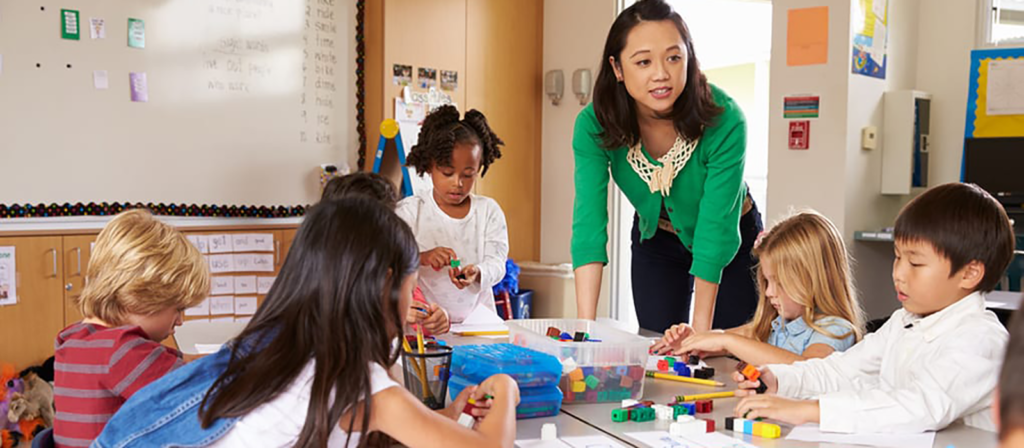
Children Obtain Certain Skills at Predictable Ages and Stages in Their Development
Understanding the milestones of child development is central to implementing developmentally appropriate practice. Although every child is unique and development is influenced by both biological and environmental factors, research consistently shows that children generally acquire specific skills within predictable age ranges. This knowledge allows educators to anticipate developmental needs, plan suitable learning experiences, and scaffold new skills appropriately.
Infants (0-6 months)
In the first six months of life, infants experience rapid growth across all developmental domains.
While each baby progresses at their own pace, certain milestones are typically observed during this period.
Physical Development:
- Developing head control
- Beginning to roll from tummy to back
- Reaching for objects and grasping reflexively
Cognitive Development:
- Recognizing caregivers’ faces and voices
- Starting to track moving objects visually
- Responding to simple cause-and-effect (e.g., smiling when smiled at)
Social-Emotional Development:
- Exhibiting early social smiles
- Developing trust through consistent, nurturing interactions
Educators applying developmentally appropriate practices for infants create calm, sensory-rich environments.
They provide safe spaces for tummy time, offer visually stimulating materials, and focus on responsive, warm caregiving.
In developmentally appropriate practice activities, caregivers sing, read, and talk to infants, even when infants cannot yet respond verbally.
This early engagement lays the groundwork for later language and emotional development.
Babies (6-12 months)
From six to twelve months, babies transition from largely passive beings to active explorers.
Physical Development:
- Sitting independently
- Beginning to crawl and possibly pull to stand
- Fine motor improvements, such as transferring objects between hands
Cognitive Development:
- Developing object permanence (understanding that objects exist even when not seen)
- Beginning basic problem-solving by trial and error
- Imitating simple actions
Social-Emotional Development:
- Displaying stranger anxiety and strong caregiver attachment
- Expressing a wider range of emotions
At this stage, developmentally appropriate practice activities emphasize safe exploration and sensory discovery.
Classrooms and homes aligned with developmentally appropriate practice principles offer:
- Soft climbing structures
- Simple cause-and-effect toys
- Opportunities for peek-a-boo and hide-and-seek games
By understanding the meaning of developmentally appropriate practice, educators ensure experiences match babies’ burgeoning curiosity and need for movement.

Receive a free catalog and custom layout to help you design your ideal classroom easily.
Toddlers (12-24 months)
Toddlers between 12 and 24 months experience monumental growth.
Their desire for autonomy explodes, along with rapidly advancing communication and motor skills.
Physical Development:
- Walking independently
- Beginning to run and climb
- Scribbling with crayons
Cognitive Development:
- Engaging in pretend play
- Naming familiar objects and people
- Following simple directions
Social-Emotional Development:
- Displaying assertiveness (“I’ll do it!”)
- Seeking approval from adults
- Experiencing big emotions and limited self-regulation
Developmentally appropriate practices for toddlers include giving choices, offering simple two- or three-step tasks, and accepting that mistakes are part of the learning process.
The importance of developmentally appropriate practice becomes clear when toddlers are allowed to explore within safe limits, build early independence, and receive patient emotional coaching.
Toddlers (2-3 years)
During the second and third years, toddlers’ abilities grow more sophisticated, though their need for boundaries and support remains strong.
Physical Development:
- Improving balance and coordination
- Kicking balls, climbing ladders, and riding tricycles
Cognitive Development:
- Expanding vocabulary dramatically
- Engaging in more complex symbolic play
- Understanding simple time concepts (“after snack, we go outside”)
Social-Emotional Development:
- Showing empathy and concern for peers
- Experiencing powerful desires for both independence and adult reassurance
Developmentally appropriate practice, preschool classrooms are designed to honor these emerging capabilities.
Centers are rich with open-ended materials; schedules provide both choice and predictable structure.
Teachers trained in developmentally appropriate practice understand that tantrums and defiance are everyday developmental tasks, not misbehavior.
Preschoolers (3-4 years)
Between the ages of three and four, children enter a period of remarkable growth that bridges early exploration and more structured learning. Preschoolers are increasingly independent, eager to interact with their peers, and motivated to understand the world around them.
Physical Development:
- Mastering jumping, galloping, and throwing with increased control
- Improving handwriting and fine-motor precision
Cognitive Development:
- Grasping more complex, multi-step instructions
- Beginning early reading, writing, and mathematical thinking
Social-Emotional Development:
- Developing stronger friendships
- Navigating group dynamics and social norms
- Expressing opinions assertively
Applying developmentally appropriate practices for kindergarten ensures that learning remains active, inquiry-driven, and emotionally safe.
Kindergarteners need play, movement, and choice embedded into their day to succeed.
Developmentally appropriate practice in early childhood programs recognizes that pushing children into overly academic, sit-down tasks too early can cause frustration, anxiety, and learning loss.

How Does Developmentally Appropriate Practice Support Children’s Development?
Developmentally appropriate practice (DAP) is more than a teaching method; it is a philosophy that ensures every child’s growth is nurtured in a way that honors their individuality and cultural background. This approach supports children’s development across emotional, cognitive, physical, and social domains by responding to where they are, respecting their pace, and building on their strengths.
Understanding the meaning of developmentally appropriate practice provides educators with the tools to create environments that are both responsive and challenging, fostering resilience, creativity, and a lifelong love of learning.
1. Teachers Meet Children Where They Are Developmentally and See Them as Individuals
One of the foundational aspects of developmentally appropriate practice is that teachers recognize and honor the individual paths children take in their learning journeys. No two children grow at precisely the same rate, and effective educators avoid one-size-fits-all approaches.
Rather than viewing development as a linear checklist of milestones, teachers informed by developmentally appropriate practice principles see a dynamic, complex process. They know that one child’s early interest in numbers might coexist with slower language development, while another child’s strong emotional sensitivity could enrich peer interactions even as fine motor skills are still emerging.
This individual’s responsiveness reflects the developmentally appropriate practice definition, ensuring each child is challenged just enough to promote growth without causing frustration or disengagement. Through observation, documentation, and flexible planning, teachers tailor their approaches to support each child’s unique combination of abilities, interests, and learning styles.
2. Teachers Acknowledge Each Child’s Social and Cultural Context
Developmentally appropriate practice in early childhood programs emphasizes that children’s development cannot be understood apart from the social and cultural environments in which they live. Family traditions, languages, community values, and societal structures deeply shape how children see themselves and engage with the world.
Educators applying developmentally and culturally appropriate practice actively seek to learn about their students’ backgrounds and incorporate this knowledge into the curriculum. This approach moves beyond surface-level multicultural activities; it involves meaningful inclusion of diverse perspectives, materials, and family experiences into the daily life of the classroom.
Teachers acknowledge cultural variation in developmental expectations, such as different views on independence, communication styles, or social roles, and adjust practices accordingly. For example, an educator might adapt group work expectations to accommodate children from cultures that emphasize community collaboration over individual competition.

Receive a free catalog and custom layout to help you design your ideal classroom easily.
Developmentally Appropriate Practice Benefits
The importance of developmentally appropriate practice lies not only in supporting individual children’s growth but also in fostering vibrant, resilient classroom communities where every child has the opportunity to thrive. When developmentally appropriate practices are consistently applied, both immediate and long-term benefits emerge for children, families, and society.
1. Children Learn to Respect Each Other’s Differences
One profound benefit of developmentally appropriate practices in early childhood is the cultivation of mutual respect among children, by honoring each child’s unique background and abilities, educators model and teach acceptance, empathy, and celebration of diversity.
Classroom activities that encourage children to share their experiences, listen to others, and work collaboratively foster an environment where differences are seen as strengths rather than obstacles. Children learn that everyone brings something valuable to the table, whether it’s a different way of solving a problem, a unique tradition, or a new language.
Teachers practicing developmentally appropriate teaching practices also explicitly teach social skills like active listening, perspective-taking, and respectful disagreement—skills that are essential for life in increasingly diverse communities.
In this way, developmentally appropriate practices not only nurture academic growth but also build the foundation for ethical citizenship and global understanding.

2. Children Learn to Be Persistent When Facing Challenges
Children need opportunities to struggle productively and develop persistence. Developmentally appropriate practice supports resilience by providing challenges that are achievable but not trivial.
Rather than rescuing children immediately when they encounter difficulty, teachers encourage problem-solving, celebrate effort, and frame mistakes as opportunities for learning. For example, a preschool teacher might support a child’s repeated attempts to balance blocks into a tower, offering encouragement rather than stepping in to correct the structure.
This approach, deeply embedded in the meaning of developmentally appropriate practice, helps children internalize a growth mindset: the belief that abilities can develop through effort and perseverance.
By designing environments and experiences that appropriately challenge children, educators nurture determination, creativity, and self-confidence—traits that serve children far beyond the classroom.
3. Teachers Focus on Children’s Levels of Understanding
Effective learning occurs when instruction matches children’s current level of understanding while offering pathways for extension. In developmentally appropriate practices for early childhood education, teachers engage in continuous observation and flexible planning to adjust instruction in real time.
Rather than teaching to an imagined “average,” educators focus on scaffolding each child’s learning. They ask probing questions, introduce new vocabulary, or present slightly more complex materials based on what they observe children attempting and mastering.
This differentiated instruction embodies the developmentally appropriate practice activities for preschoolers, where the same general theme (such as “community helpers”) might be explored through storytelling by some children, dramatic play by others, and building models by yet others.
Focusing on individual understanding ensures that learning is meaningful, challenging, and joyful—true hallmarks of developmentally appropriate practices in early childhood.

Using Developmentally Appropriate Practice Strategies in the Classroom
Implementing developmentally appropriate practices in the classroom requires intentional strategies that align philosophy with action. Effective classrooms are ecosystems where all elements—community, teaching, curriculum, motivation, assessment, support, and family engagement—work together to create environments in which children thrive.
Community of Learners
A sense of belonging is critical to learning. Teachers who prioritize a community of learners ensure that every child feels valued, respected, and connected to others.
Strategies for building community include:
- Morning meetings where children greet one another
- Cooperative learning projects
- Celebrations of individual and group achievements
- Classroom agreements created collaboratively with children
Establishing community reflects the principles of developmentally appropriate practice, where social and emotional development are considered equally important to cognitive growth.
Teaching
Teaching within a DAP framework is dynamic and responsive, not rigid or standardized.
Educators use a variety of techniques to address diverse learning styles, developmental stages, and cultural backgrounds, including:
- Scaffolding new concepts with visual, tactile, and auditory supports
- Using questioning strategies that provoke curiosity and critical thinking
- Allowing children to explore topics through self-directed inquiry
Practical developmentally appropriate practice activities empower children to construct their understanding, with teachers acting as facilitators and guides rather than sole sources of knowledge.

Receive a free catalog and custom layout to help you design your ideal classroom easily.
Curriculum
A developmentally appropriate curriculum is flexible, emergent, and deeply rooted in children’s interests and developmental needs.
Curricula aligned with DAP:
- Offer broad exploration across domains (literacy, math, science, arts, social studies)
- Integrate play-based and project-based learning
- Connect new concepts to children’s real-world experiences
Rather than following a rigid script, DAP curricula adapt to the evolving needs of the children, ensuring relevance, engagement, and more profound mastery.
Motivating
In developmentally appropriate practices, motivation is intrinsic, not extrinsic.
Children learn because they are curious, not because they are seeking rewards or fearing punishments.
Teachers motivate learners by:
- Offering choices within learning activities
- Connecting learning tasks to children’s interests
- Celebrating effort, creativity, and perseverance
Intrinsic motivation leads to deeper engagement, greater retention of information, and the development of lifelong learning habits.
Assessment
Assessment in DAP classrooms is ongoing, authentic, and formative.
Teachers gather information through:
- Observations
- Portfolios
- Child-led conferences
- Anecdotal records
Rather than focusing solely on standardized tests, developmentally appropriate practice assessment emphasizes understanding each child’s growth trajectory and informing future instruction.
Effective assessment practices respect children’s developmental stages and celebrate progress, not just mastery.
Supporting
Supportive DAP classrooms recognize that every child needs different types and levels of help to thrive.
Support strategies include:
- Offering scaffolded challenges
- Providing emotional coaching and modeling self-regulation
- Adjusting instructional strategy based on observation
In developmentally appropriate practice, preschool settings support is proactive, respectful, and individualized.
Families
In developmentally appropriate practice, families are recognized as children’s first and most important teachers.
Teachers strengthen school-home partnerships by:
- Communicating regularly with families about children’s progress and experiences
- Valuing families as experts on their children
- Inviting family participation in classroom events and curriculum planning
Building strong relationships with families ensures that education is a collaborative effort and that children’s development is supported consistently across settings.

FAQs
1. What are some misconceptions about developmentally appropriate practice?
One common misconception is that developmentally appropriate practice means avoiding academic content altogether.
In reality, DAP includes academic learning but presents it in ways that align with children’s developmental readiness, interests, and learning styles.
Another misconception is that DAP lacks structure, but effective DAP classrooms are carefully organized to balance exploration with intentional teaching.
2. How does developmentally appropriate practice change across different age groups?
Developmentally appropriate practices evolve as children grow.
For infants and toddlers, DAP emphasizes secure attachments and sensory exploration.
In preschool, the focus shifts to language development, social collaboration, and imaginative play.
By kindergarten and early primary grades, DAP integrates more structured academic content while continuing to support hands-on, inquiry-based learning experiences.
3. How do teachers stay current with best practices in developmentally appropriate education?
Educators committed to developmentally appropriate practice engage in ongoing professional development.
They attend workshops, collaborate with peers, study current child development research, and reflect regularly on their teaching strategies.
Professional learning communities and continuous assessment of classroom practices help teachers adapt and refine their approaches to meet the evolving needs of children.
4. How does developmentally appropriate practice support inclusive education?
Developmentally appropriate practice is inherently inclusive because it starts with recognizing each child’s unique strengths, needs, and backgrounds.
Rather than trying to fit children into a one-size-fits-all mold, DAP emphasizes adapting environments and experiences to support every learner, including those with disabilities, diverse cultural backgrounds, and varying developmental rates.
5. Can developmentally appropriate practice be applied in virtual or hybrid learning environments?
Yes, the core principles of developmentally appropriate practice—respecting individual development, promoting active engagement, and fostering relationships—remain vital in virtual or hybrid settings.
Teachers can create developmentally appropriate online experiences by incorporating hands-on activities at home, maintaining regular personal connections with students, and adapting technology use to suit children’s developmental levels.
6. What role does environment design play in developmentally appropriate practice?
The physical environment is a critical component of developmentally appropriate practice.
Classrooms designed according to DAP principles are welcoming, flexible, and organized to promote independence, exploration, and collaboration.
Materials are accessible to children, learning centers support a variety of developmental domains, and the space is structured to encourage both individual and group activities that match children’s developmental needs.
Conclusion
Throughout early childhood, children’s cognitive, social, emotional, and physical growth unfolds at different rates. By meeting children where they are and thoughtfully guiding them forward, teachers using developmentally appropriate practices lay a strong foundation for academic achievement, emotional resilience, and lifelong curiosity.
Effective DAP classrooms recognize the importance of play, relationships, choice, cultural relevance, and individualized instruction.
They empower children to become active participants in their learning journeys rather than passive recipients of information.
Ultimately, developmentally appropriate practice ensures that early education is not only practical but also joyful, meaningful, and deeply respectful of the incredible potential within every child.
When educators, families, and communities commit to the principles of DAP, they nurture a generation of learners who are confident, compassionate, and prepared to thrive in a complex, ever-changing world.







